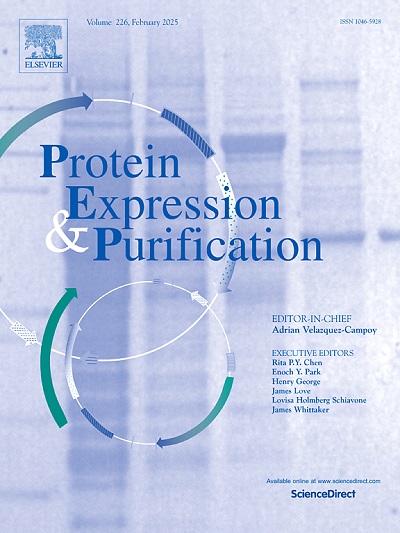梅花鹿胸腺蛋白酶α原蛋白的表达、纯化及活性研究
IF 1.2
4区 生物学
Q4 BIOCHEMICAL RESEARCH METHODS
引用次数: 0
摘要
目的对梅花鹿胸腺蛋白酶α (PTMA)蛋白进行原核表达和纯化,为进一步研究PTMA蛋白的活性奠定基础。方法合成PTMA片段并将其克隆到pET21a-PTMA载体中。采用大肠杆菌BL21 (DE3)对PTMA蛋白进行原核表达,通过十二烷基硫酸钠-聚丙烯酰胺凝胶电泳和含镍电泳对表达产物进行分析。用聚丙烯酰胺凝胶电泳分析表达产物,用镍离子亲和层析纯化。利用质谱法鉴定片段,并分析其在MC3T3-E1和ATDC5细胞中的活性。结果成功构建了pET21a-PTMA表达载体,蛋白纯度达到93%以上。纯化后的蛋白在MC3T3-E1和ATDC5细胞中均显示出增殖活性。结论成功构建了稳定的PTMA表达载体,获得了高纯度的PTMA蛋白,为进一步研究PTMA活性及其在骨病中的作用奠定了基础。本文章由计算机程序翻译,如有差异,请以英文原文为准。
Expression, purification, and activity of sika deer prothymosin α protein
Objective
To perform the prokaryotic expression and purification of sika deer prothymosin α (PTMA) protein and lay a foundation for the subsequent study of PTMA protein activity.
Methods
The PTMA fragment was synthesized and cloned into the pET21a-PTMA vector. Escherichia coli BL21 (DE3) was used for the prokaryotic expression of the PTMA protein, and the expression products were analyzed by sodium dodecyl sulfate-polyacrylamide gel electrophoresis and nickel-containing electrophoresis. Polyacrylamide gel electrophoresis was conducted to analyze the expression products, which were purified using nickel ion affinity chromatography. Fragments were identified using mass spectrometry and analyzed for activity in MC3T3-E1 and ATDC5 cells.
Results
The pET21a-PTMA expression vector was successfully constructed, and the protein purity reached more than 93 %. The purified protein displayed proliferative activity in both MC3T3-E1 and ATDC5 cells.
Conclusion
The successful construction of a stable expression vector and production of high-purity protein lay a foundation for future research on PTMA activity and its effects on bone diseases.
求助全文
通过发布文献求助,成功后即可免费获取论文全文。
去求助
来源期刊

Protein expression and purification
生物-生化研究方法
CiteScore
3.70
自引率
6.20%
发文量
120
审稿时长
32 days
期刊介绍:
Protein Expression and Purification is an international journal providing a forum for the dissemination of new information on protein expression, extraction, purification, characterization, and/or applications using conventional biochemical and/or modern molecular biological approaches and methods, which are of broad interest to the field. The journal does not typically publish repetitive examples of protein expression and purification involving standard, well-established, methods. However, exceptions might include studies on important and/or difficult to express and/or purify proteins and/or studies that include extensive protein characterization, which provide new, previously unpublished information.
 求助内容:
求助内容: 应助结果提醒方式:
应助结果提醒方式:


